Physical Address
304 North Cardinal St.
Dorchester Center, MA 02124
Preoperative planning includes the following methods to confirm and define the extent of the condition: using palpation, ultrasonography (US), computed tomography (CT) or magnetic resonance imaging (MRI). Be mindful of the regional anatomy. Previously removed cysts may be surrounded by fibrotic scar tissue.
Methods of anesthesia, such as topical and local anesthesia (including tumescent anesthesia), nerve block, and general anesthesia, should be considered. Prior to injecting local anesthesia, palpate the mass to determine its mobility and draw the lateral margins and the incision line.
When cysts are mildly inflamed or have drainage, a short course of oral antibiotic is reasonable.
Inflamed or infected cysts and abscesses are drained by a stab incision. The cavity is probed with a curette and irrigated. Packing can be performed.
Subcutaneous lesions, such as lipomas and epidermal cysts, are a common concern and are often found during the examination of the patient. Through the proper use of incision, draining, and exteriorization techniques, physicians can effectively treat their patients. This chapter describes techniques for incision, draining, and exteriorization of several types of subcutaneous lesions, the preoperative and postoperative management, and the potential pitfalls and complications to help ensure a successful outcome.
The origins of incisional surgery date back to 1800 bc , where they can be found in the Egyptian practice of medicine and surgery. Incisional surgery and draining and exteriorization techniques are widely employed for the removal of various benign subcutaneous processes such as epidermal and pilar cysts, and lipomas. Incision, drainage, and exteriorization of abscesses and infected, inflamed cysts can also be accomplished by this method.
Preoperative evaluation including current medications and allergies, and vital signs, including blood pressure and pulse, are always important to obtain. Anesthesia method, including topical anesthesia, local anesthesia, nerve block, and general anesthesia, should be considered. When removing large lesions, such as large cysts and lipomas, consider using dilute local anesthetic as is performed with tumescent anesthesia. One must also be aware of the surrounding structures, taking into consideration the underlying nerves, blood vessels, and other important anatomic structures.
Removing subcutaneous masses in certain anatomic sites and conditions can be challenging if one is not familiar with the local anatomy. The surgeon must always be mindful of the underlying anatomic structures. Radiologic studies, including CT scans and MRI, are useful to confirm the local existence and extent of tumor. Ultrasonography is very useful because it is simple, easy and not invasive. Cysts, particularly, and other subcutaneous lesions that have been previously treated will often be surrounded by considerable fibrosis and scar tissue, complicating their removal. It is therefore important to clarify the past medical history of treatment. In order to anticipate difficulty, careful palpation of the mass with the thumb and forefinger, as well as both forefingers, is performed to assess the mobility and character of the tissue surrounding the lesion ( Fig. 12.1 ). Areas of scar tissue are identified, as well as larger blood vessels and other underlying structures.
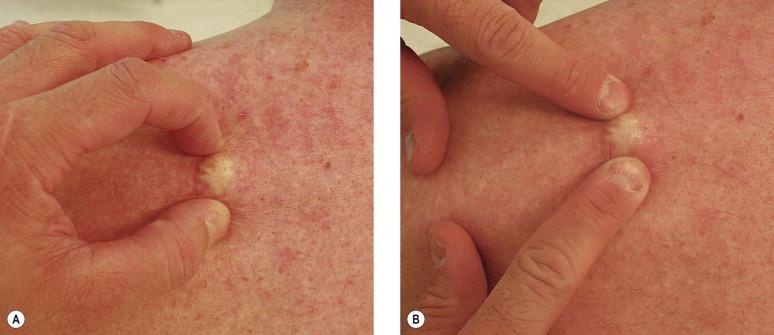
Before the anesthetic injection, it is useful to mark both the lateral margins of the lesion to be removed and the anticipated incision line parallel to the relaxed skin tension lines. Since facial wrinkles and body skin tension lines are influenced by gravity, the planned incision line should be confirmed by examining the patient in various positions, such as standing, sitting and supine position. After the anesthetic is injected, the relaxed skin tension lines may be difficult to see and small or deep subcutaneous lesions may be difficult to palpate or locate.
Clinically, lipomas are slow-growing, mobile masses with lobulations that can range in size from a few millimeters to over 20 cm and are usually encapsulated. Although they can cause discomfort by pressing on nerves, and may grow rapidly, most lesions are asymptomatic. They may be solitary or multiple. The most common sites are the subcutaneous tissue of the neck, shoulders, and back, followed by the forearms and buttocks. Lipomas that occur on the forehead, which are frequently located below the frontalis muscle, and the scalp present a special problem for removal, as they can be difficult to mobilize. Infiltrating lipomas of the upper extremities may be deep and involve the muscles, as well as neural and vascular structures. When lesions are large or deep, preoperative radiologic studies, such as CT scan and MRI, should be performed. Lipomas rarely become inflamed. They are most commonly removed because they become symptomatic or cosmetically objectionable.
Carefully mark the lateral margins of the lipoma with a surgical marking pen, the planned incision is preferably over the center of the lesion and aligned within the relaxed skin tension lines. When a biopsy scar is present, the planned incision line should be converted to a fusiform excision including the scar ( Fig. 12.2 ). Plan on an incision length of one-half to one-third of the lesional diameter of the underlying lipoma. Most lipomas will compress or mold with lateral pressure and can be removed through a smaller incision, allowing for a smaller, more cosmetically acceptable scar. If one encounters a considerably larger lesion, fibrosis, or other difficulties, the incision can then be lengthened intraoperatively to facilitate removal.
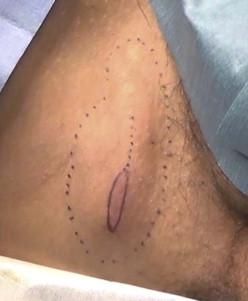
The local anesthetic is injected over and around and under the lesion. By injecting all around the lesion and using a generous volume of anesthetic, the lesion can be partially dissected from the surrounding tissue.
Make the skin incision along the previously inked line. In general, the first tissue to appear is normal subcutaneous adipose tissue. The lipoma becomes evident when the normal adipose tissue is incised. The lipoma will usually be lighter in color and firmer than the surrounding adipose tissue. After making the incision, blunt dissection can usually be accomplished with a curved hemostat, Ragnell, or Metzenbaum scissors. Blunt dissection with the fingers is also useful, especially in large lesions. The lesion may be round or oval but also may have a lobulated shape. Once the lipoma has been dissected free, apply lateral compression to squeeze it through the skin incision ( Fig. 12.3 ). If the lipoma is too large for removal through the existing incision, the incision can be lengthened. Be careful to examine the base of the lipoma as it is removed, to avoid damaging any underlying structures that may still be attached.
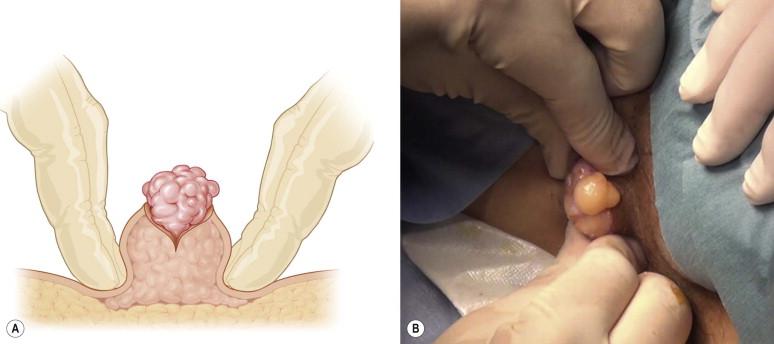
After the lipoma is removed, use skin hooks to expose the wound base to identify bleeding, and cauterize as necessary. Meticulous hemostasis must be obtained when excising subcutaneous lesions. The use of pressure dressings and/or drains may be necessary due to the location or size of the lesion. Negative pressure drains, such as J-VAC or Redivac, are desirable for a large lipoma or for regions which cannot have pressure applied or remain in a resting state because of the close proximity of a joint. Drains, if employed, are typically removed in 72–96 h. Smaller dead spaces will usually not require any further attention but larger defects may require approximation of the subcutaneous tissue to decrease the risk of hematoma and prevent dimpling of the overlying skin.
Wound closure is usually accomplished by approximating the subcutaneous tissue and dermis with an absorbable suture such as Vicryl (Ethicon, Johnson & Johnson Co, Somerville, NJ). The epidermal edges are then apposed with a non-absorbable suture such as Prolene (Ethicon) or Ethilon (Ethicon). Since the overlying skin is not excised, there is little tension on the skin edge. For large lipomas and cysts, it may be necessary to excise some overlying skin to flatten the incision. On the face, a running subcuticular closure in combination with Steri-Strips (3M, New York) and an adhesive such as Mastisol (Ferndale Laboratories, Inc, Ferndale, MI) works well.
A clinical entity termed frontalis-associated lipoma of the forehead presents special difficulty in removal. Forehead lipomas can be found both within the frontalis muscle and between the muscle and submuscular fascia. In removing these lipomas, care must be taken not to cause undue damage to the frontalis muscle. Other important structures to consider are the supraorbital and supratrochlear neurovascular bundles ( Fig. 12.4 ). Because these lipomas often lie deep to the frontalis muscle, the supraorbital and supratrochlear neurovascular bundles can be injured if care is not taken during removal. Frontalis-associated lipomas can be quite adherent to the underlying tissue. The injection of local anesthesia into the underlying tissue with an echo guide makes dissection easier ( Fig. 12.5 ). After making a horizontal incision within the relaxed skin tension lines, the frontalis muscle is located and carefully dissected vertically to separate the muscle fibers, or partially resected to allow access to the lipoma. Once the capsule of the lipoma becomes evident, careful dissection is carried out to free the lipoma along all of its borders. Blunt scissors or a small hemostat work well. After the superficial surface of the lipoma has been adequately undermined, the deep surface of the lipoma is also thoroughly undermined. Small lesions may be removed intact and larger lesions are sometimes removed in pieces to avoid a larger incision. Normally, tumors are approached from directly above, but when a lipoma is present near the hairline, an incision line may be aesthetically designed in the hairline to make the wound scar less noticeable ( Fig. 12.6 ). When the tumor is distant from the incision, endoscopic support is advantageous. It is important to restore good structural integrity to the forehead after the lipoma has been removed. The submuscular fascia is reapproximated using deep absorbable suture and then the frontalis muscle is also reapproximated prior to closing the subcutaneous tissue. A pressure dressing for 24 h is helpful to avoid accumulation of fluid in the dead space.
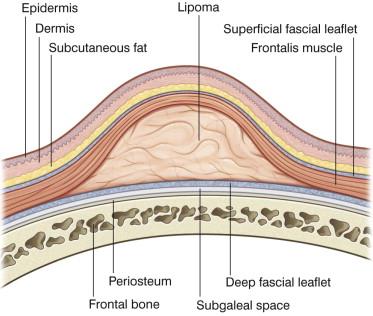
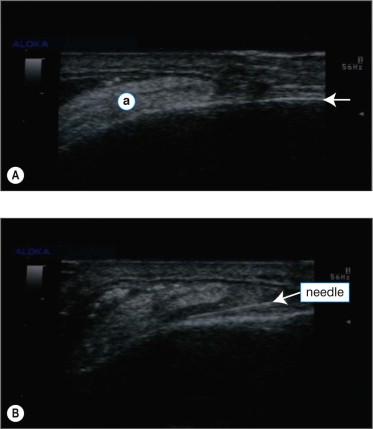
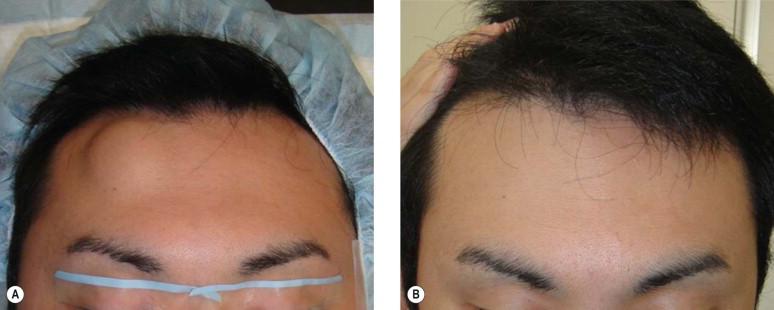
Infiltrating lipomas of the upper extremities can be both intermuscular and intramuscular. The more common intermuscular variant arises in the intermuscular fascial septae and may infiltrate into adjacent muscle. Intramuscular lipomas arise within the muscle and are poorly demarcated. These lipomas are frequently firmer than ordinary lipomas. Most infiltrating lipomas of the upper extremities are asymptomatic; however, they may cause pain by compressing adjacent structures. In addition, weakness may occur due to nerve compression. Radiologic studies, including computed tomography (CT) scans and magnetic resonance imaging (MRI) are very useful in assisting with the diagnosis and planning surgical treatment ( Fig. 12.7 ). It is very important to determine the extent of the lipoma prior to excision, to ensure that it is completely removed. These infiltrating lipomas frequently require an incision which is larger than for ordinary lipomas.
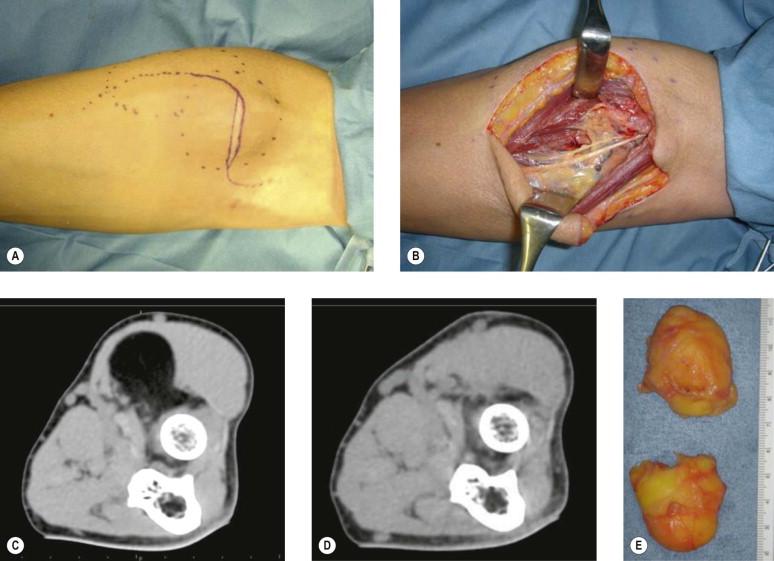
Great care needs to be taken dissecting these lipomas free from surrounding muscle and neuromuscular structures. A multilayered closure which includes the fascia and subcutaneous tissue allows for optimal results. In larger cases, a drain, which is usually removed 24–48 h postoperatively, may be appropriate. For infiltrating lipomas in dangerous anatomic locations such as overlying Erb's point, dissection may not be performed without a nerve stimulator ( Fig. 12.8 ).
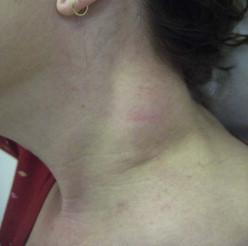
Become a Clinical Tree membership for Full access and enjoy Unlimited articles
If you are a member. Log in here